This was one pissed off magpie.
Yesterday morning I photographed a Black-billed Magpie as it made repeated attacks on an intermediate morph Swainson’s Hawk in northern Utah. The birds were far away so I’ve had to crop these photos significantly which resulted in mediocre image quality (at best) but I think they’re good enough for documentary purposes.
This was more than just harassment. I saw the magpie bite the hawk and pull its tail feathers several times so I feel justified in calling this overall behavior an attack. I took hundreds of shots over a 4+ minute period and the behavior began long before I was able to get my lens on the birds. I can only surmise the magpie had a nest in one of the nearby trees but I never did spot it.
All images are presented in the order they were taken.
The magpie was both fearless and relentless in its attacks. At first the hawk did its best to ignore the highly aggressive corvid but
it really had no choice but to keep a very close eye on the magpie and…
defend itself when necessary.
The hawk kept turning on its perch in an attempt to face the incoming magpie but the tree was thick with twigs and branches that hindered its ability to maneuver. One time the hawk slipped and fell flat on its face in the branches and it took a few moments to recover.
Usually the magpie instinctively approached from behind and about all the Swainson’s could do was turn its head and watch as the aggressive bird attacked its vulnerable rear end.
Here the hawk was turning to face the magpie coming in from our right but before it was stable on the branch the magpie was already behind “him”.
I include this shot because it makes me smile. It looks like the Swainson’s was about to poop disdainfully on the magpie but in reality it was only trying to regain its balance after an awkward defensive maneuver.
The speed and maneuverability of the smaller magpie as compared to that of the hawk was truly impressive – it seemed like the hawk was always facing a direction the magpie had already left. The Swainson’s was not having any fun!
Occasionally the magpie would land on a nearby branch and watch as the hawk tried to recover. I couldn’t help wondering if the magpie was amused by the predicament of the larger predatory bird.
But the respite for both birds would only last for a few moments before the magpie resumed its aerial attacks.
Eventually the hawk made a half-hearted attempt at turning the tables and going after the magpie but all it succeeded in doing…
was getting hung up in the twigs when one of its feet slipped on a branch. Just before this shot the hawk had done a face-plant into the spiny twigs below its face and here it’s attempting to recover. The magpie almost seems to be taunting the larger bird during the process.
Soon the hawk flew a short distance to another nearby tree but that didn’t satisfy the magpie so it continued its aggressive behavior. With its rear end and tail once again vulnerable to the magpie the hawk…
eventually decided to get the hell out of Dodge and vacated the area.
Magpie wins. End of story.
Ron


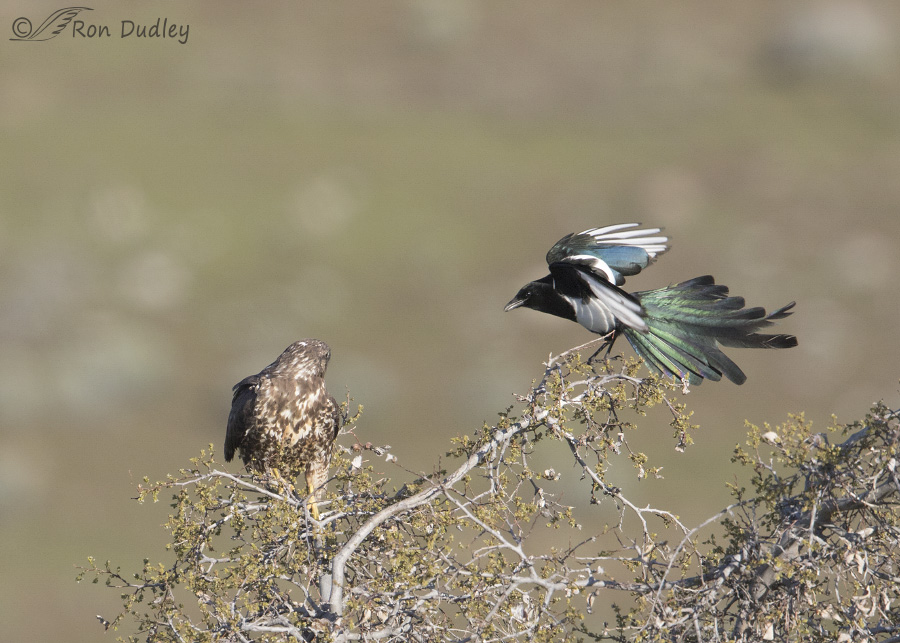
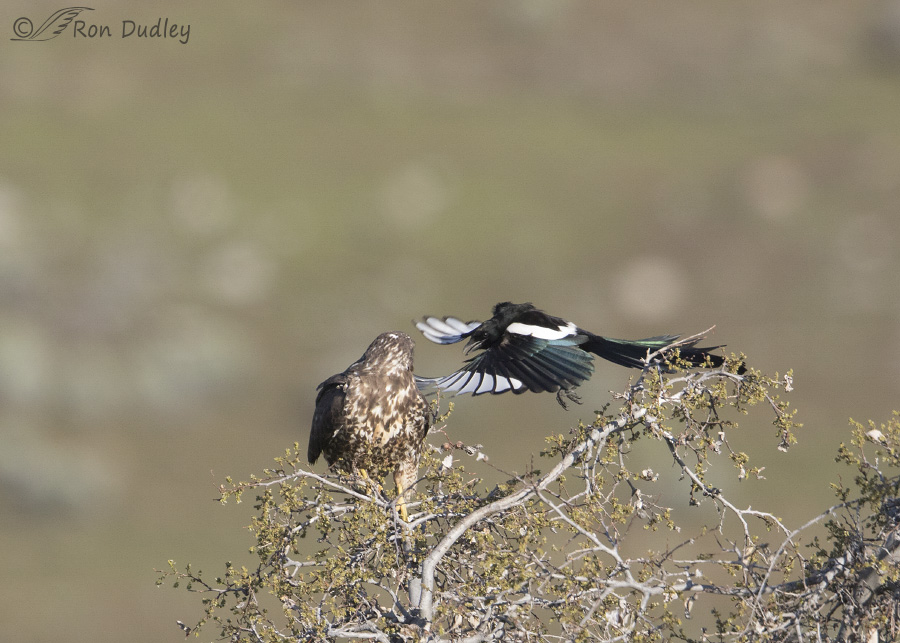
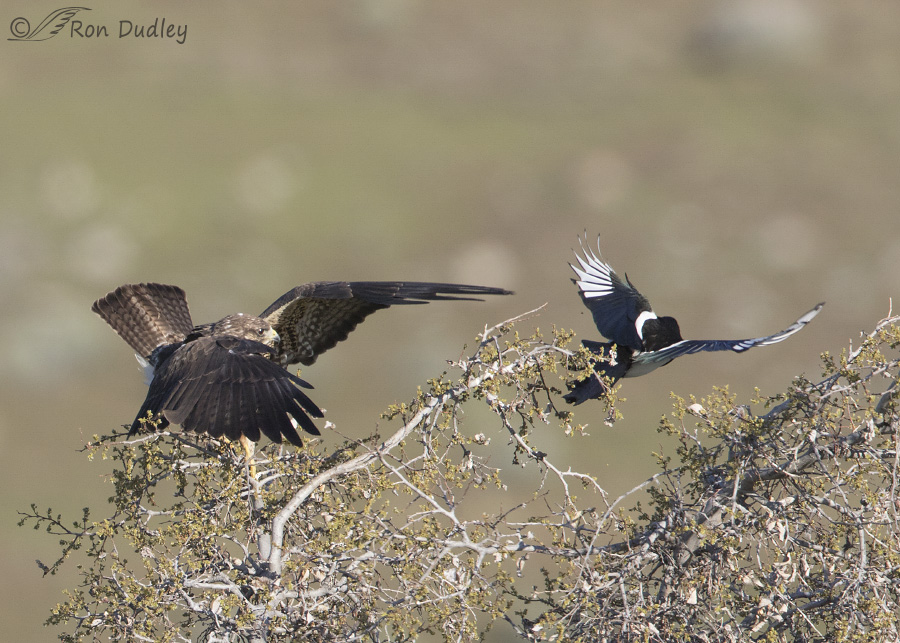
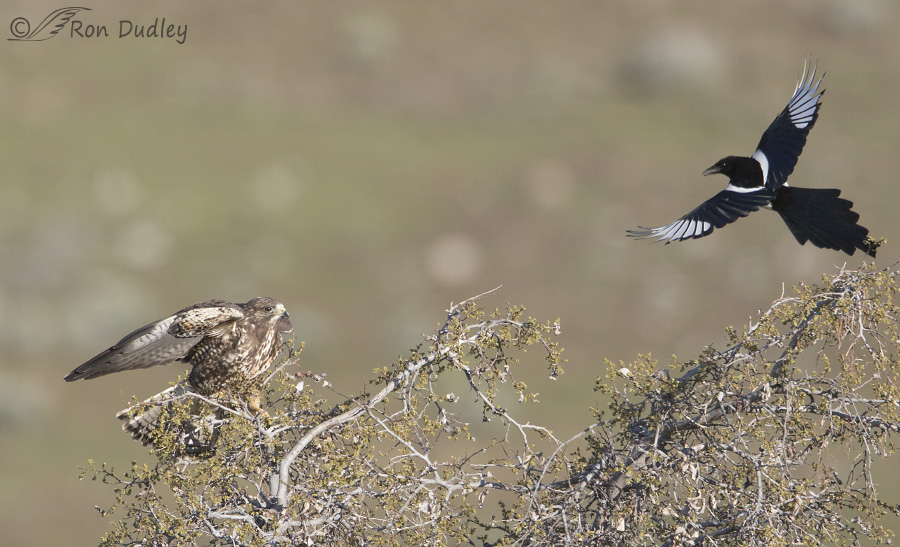
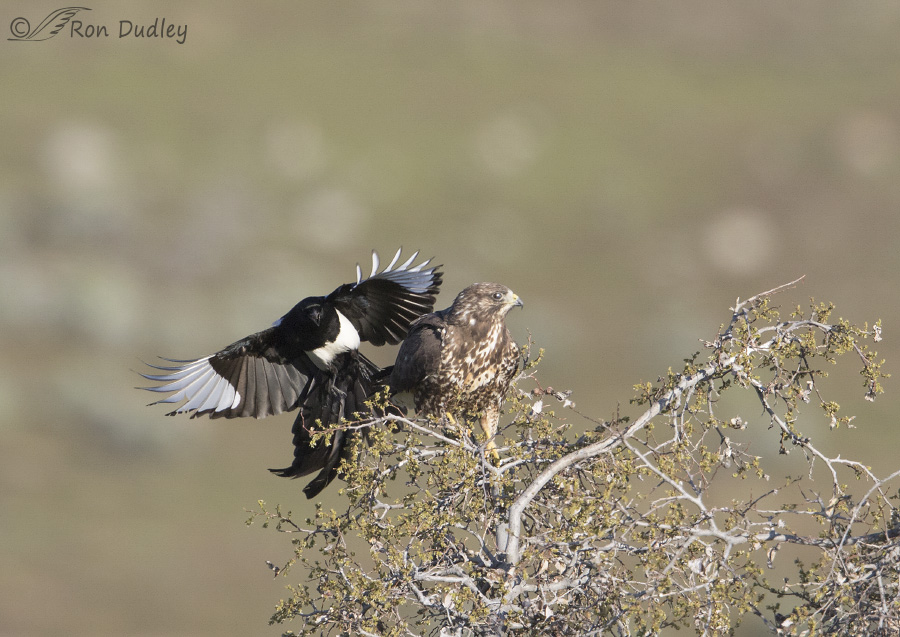
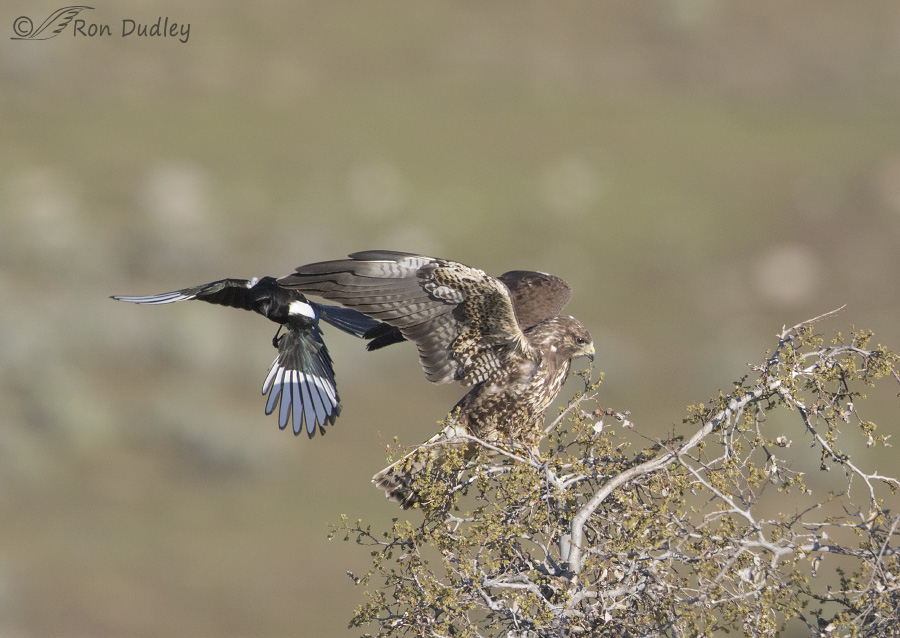
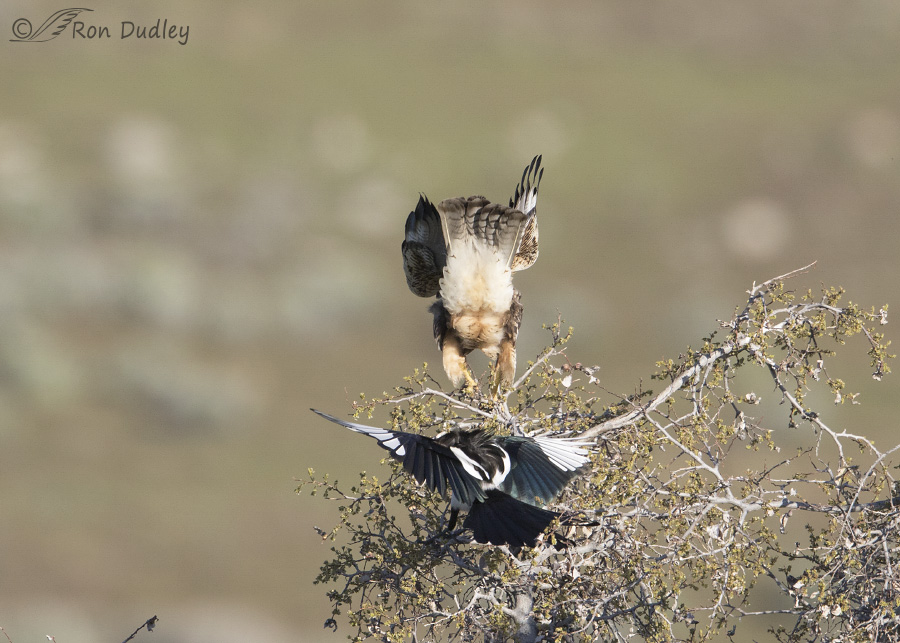
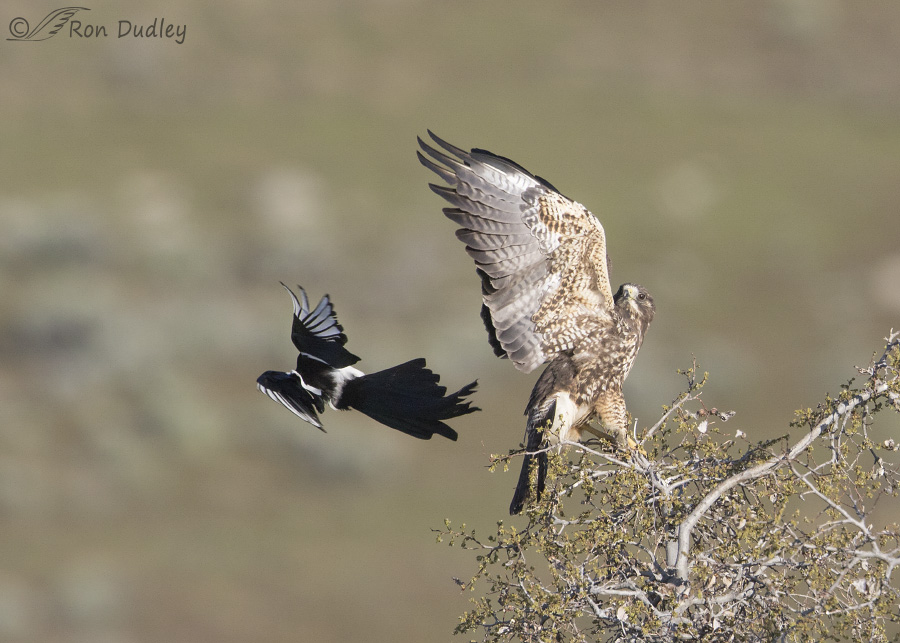
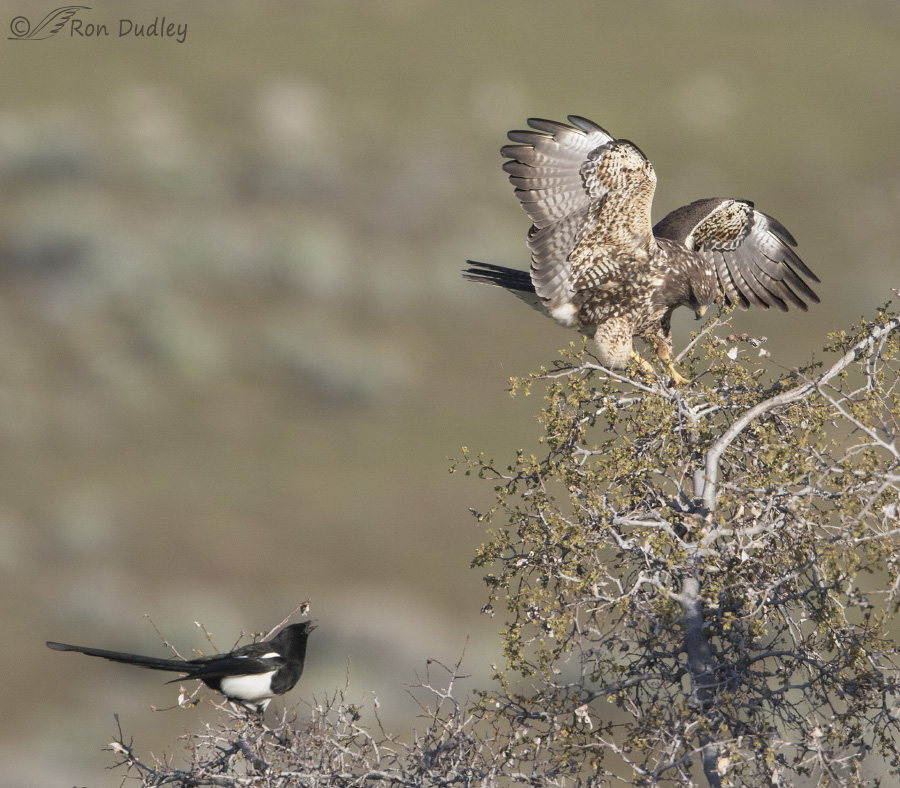
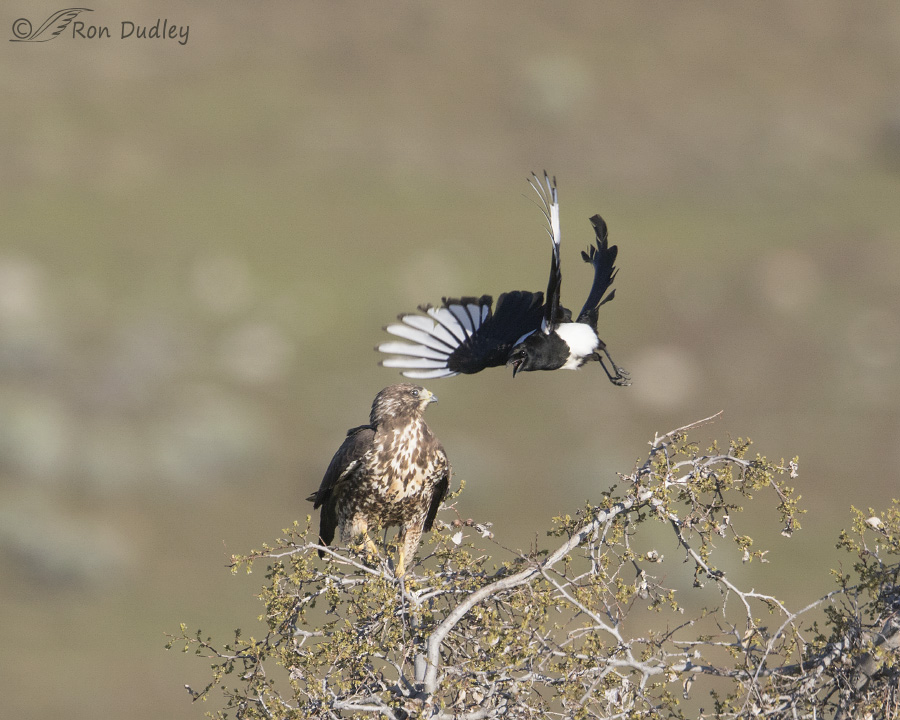
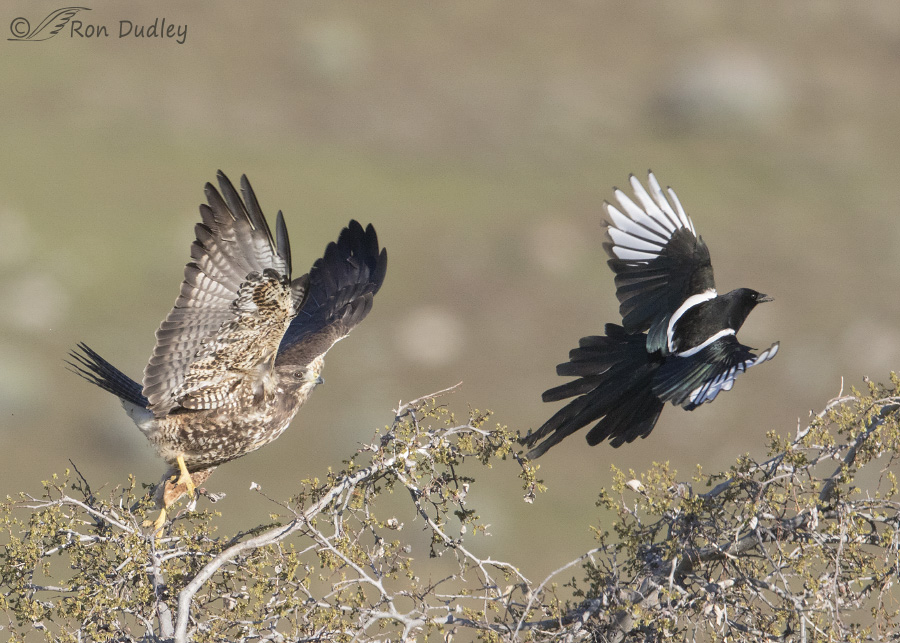
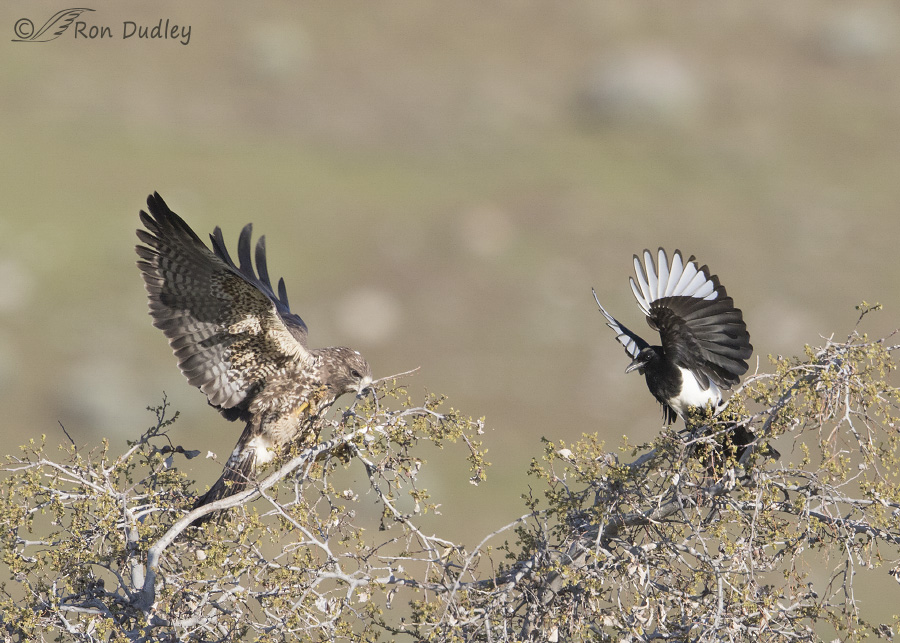
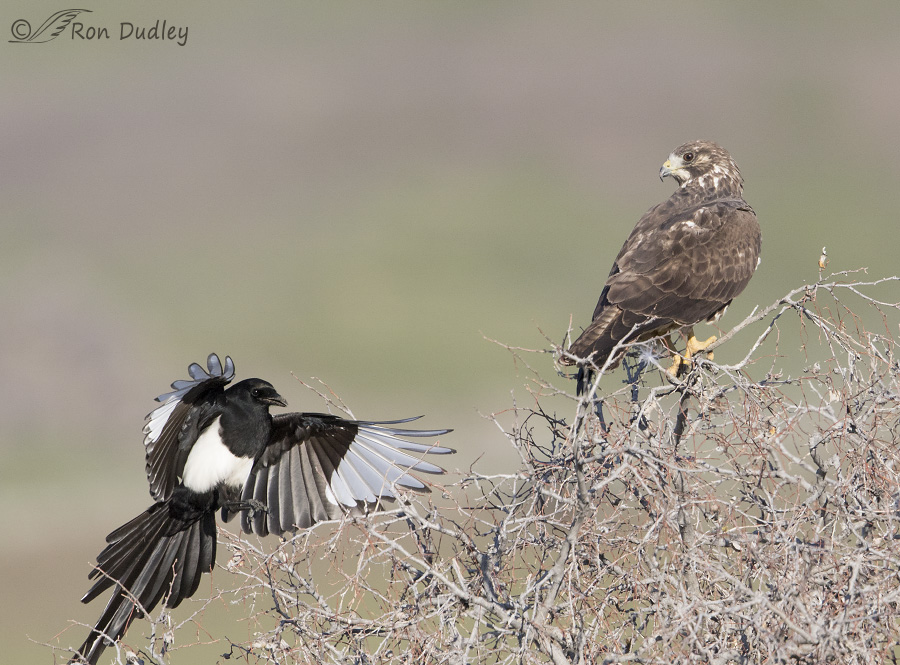
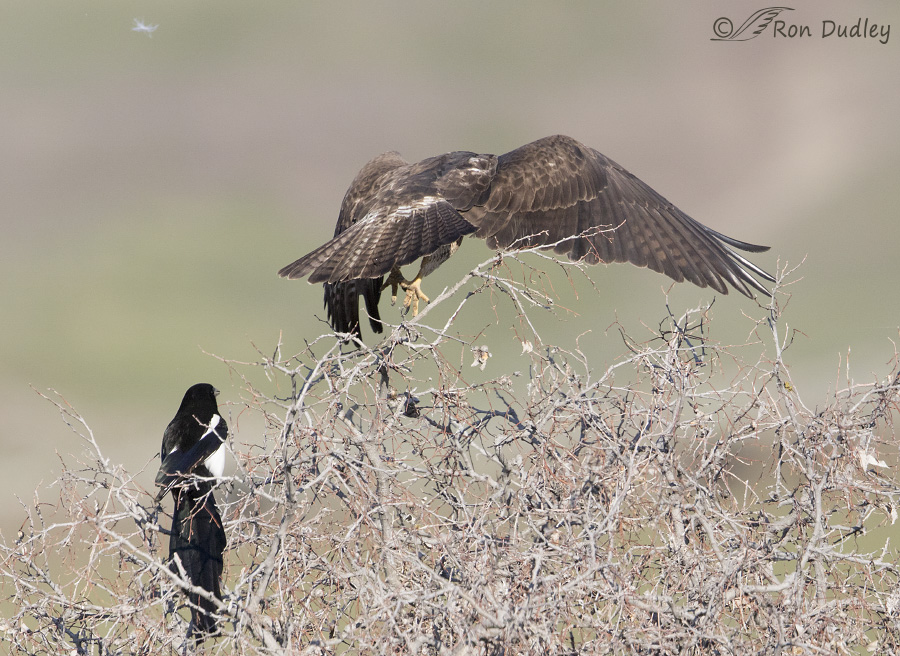
Two of my favorite species! YEE HAW! Sorry to be late to this party (hurty hands), but I always wonder why the larger raptors INSIST upon perching at the very tippy top of things that are nearly impossible for them to maintain that majestic thing (with secure footing) OR to make a quick and clean getaway (when necessary). Both Mariah and Jack will choose those teeny, tiny branches when they’re available. Sigh…
I so wish we had magpies here! I feel a road trip is in order soon
Wow I love this series of shots Ron. The Magpie is gorgeous. I see the crows do the same thing, only 3 at a time to a hawk here daily. Not sure who to feel more sorry for as I know there are crow babies near.
Parents of all kinds can turn into monsters when defending their territory, dens, nests, young…when people say a mother becomes a “tiger” in defense of her young, it’s so true…Some kind of fearless, super strength kicks in and God help those considered a threat!!! She has no fear, feels no pain, is red-eyed blind to all but the act of defense…Great for survival of the young, but rough as all hell on the mother and her target!!! This is such a great demonstration of that “courage”–or is it blind rage! A great, dramatic series!! I once saw a blackbird of some kind deviling a hawk. Both were in flight. Suddenly, the hawk did a loopy loop, snatched its tormenter out of the air, flew to a nearby tree with it, and started tearing it to shreds…feathers flying all over the place. I was stunned by the suddeness and speed of the hawk’s reaction when it decided it had enough…
Patty, what you describe with the hawk and the blackbird is something that I’ve heard others have seen but I’ve never had the privilege. Maybe some day…
That was great. Thanks Ron. Made me chuckle. At the Hawk’s expense.
Good. Chuckles are always good, Jean.
I suspect you are right about the magpie having a nearby nest. And would have loved to have seen this series in person. Of course I love the raptor, but I also feel for the courageous magpie.
I have seen similar things with our ‘own’ magpies who are passerines rather than corvids but still punch well above their weight on the aggressive index.
Interesting, EC. I didn’t know that your Australian magpies aren’t corvids…
I’ve heard about magpie aggression, but have never been exposed to it in action, before this terrific series of photos. A magpie that hangs around our neighborhood likes to chase the neighbor’s cat, which the cat does not appreciate. Haven’t seen much of the cat but can certainly hear the magpie.
Always love your narratives, educational and ‘from the heart’! Thanks for the photos.
Alice, magpies nesting in my yard used to sneak up behind the neighbor’s cats and pull their tails. I watched it happen several times (cheering the magpies on the entire time…).
“This was one pissed off magpie.” Wow! You can say that again! I don’t think I’d want to be on the receiving end of that temper. Eeesh!
You’ve done it again, Ron! Spectacular behavioral shots plus magnificent shots of the magpie, independent of the hawk. The first two show off the iridescence and the beautiful feather patterns so well and the 4th shot really gets the tail and the white at the base of the wings. That 4th shot makes me think of a thunderbird drawing for some reason.
I feel bad for the hawk. I wonder if it’s a juvenile and that’s why it seemed so out of its element. To me, it looks a little dark for a light morph and a little light for an intermediate morph (unless my “Google-fu” is off). I know so little about the species, so I’m hoping someone will weigh in.
This series really ought to be in a textbook or at least part of a keynote address at an ornithology conference!
Marty, the colors of each morph aren’t an absolute – there’s a gradation of colors and overall darkness in each morph. We categorize them for the sake of convenience as best we can. Thank you.
What a remarkable series of photos and the story to go with it! Thanks again!
I’m glad you like it, Pat. Thanks.
Wonderful series. Thanks!
Thank you, Karen.
Wonderful actions shots showing the flying speed and maneuverability of the magpie! I’m particularly fond of the magpie coming toward the hawk in the photo with “But the respite for both birds…” below it. Would you mind if I drew this magpie and posted the drawing on my blog?
Myriam, You have permission to use that image as a model for your drawing and then post the drawing on your blog. Please send me the link when it’s published.
Thanks very much, Ron! I appreciate the opportunity and will send you the link. I contacted you a while back through your “Contact” page about using one of your photos of a meadowlark as a drawing model. I didn’t hear back from you and am wondering whether you didn’t receive those two messages or whether I didn’t receive your response.
Wow!! I’m sure these made your day !!! Would have made mine!!!!!I still think there must have been a nest in vicinity or in progress .. it clearly was magpies territory don’t you think?
Yes, it was obviously the magpie’s territory but birds of different species often claim the same territory. And yes, it made my day.
May the most colorful – err, aggressive – bird win! Great series.
Thanks, Elmer.
Do birds have adrenaline? If so I think both of these guys were pumping it at max level. Great series.
I believe they do have adrenaline, Wendy. Thanks.
Wow– what a belligerent little cuss; great proof that size isn’t everything !
Exactly, Kris – maneuverability and speed count for a lot in these situations.
Great series Ron and thanks again for sharing. I know you said the birds were quite some distance so that probably explains why you are getting sufficient depth of field to get them both in focus with all this activity going on. If they were closer that may not have been possible. Sometimes shooting subjects at a distance has its advantages. As others have said, all great but I especially like the one with the catchlight in the eyes of both birds. Just out of curiosity, what was your aperture?
That’s exactly why I had as much DOF as I did, Frank. I was a long way from these birds.
Most of these shots were taken at either f/6.3 or f/7.1. My shutter speed was usually at or close to 1/2500 sec.
That was great! Thanks!
You’re very welcome, Jane.
Thanks for another great series. Love those Magpies!
Thanks, Joanne.
LOL, VBG!! Behavior.Behavior, Behavior – Its all about documenting behavior! Love this set and your post! As much as I love raptors and owls, you have to hand it to the Magpie he/she did a magnificent job. Makes me think of Thomas of the Celtics who scored 53 points in a championship game at only 5’9″ with all the lumbering 6’4″ and above surrounding him. Yes, I know it doesn’t have anything to do with nature photography, but just to say my hats off to the small guy!
You may have been a distance from these two, but the shots are awesome. Many thanks for sharing.
Yup, there’s just something about rooting for the underdog, Dick. Thank you.
Ron, I think one could look at the second to last picture and see disgust in the attitude and face of the Swainson’s!
AWESOME behavioral series Ron! Thanks for sharing!
Charlotte
Thank you, Charlotte.
The photos and the exchange between the birds are impressive!
Is this just instinctive Magpie behavior to protect the nest or is the threat from the Swainson’s Hawk real? Would the hawk ever prey on the young or eggs? I always thought small rodents and insects were their preferred diet, but I guess they must take small birds occasionally.
Robert, Swainson’s prey mostly on small mammals during the nesting season and insects (largely grasshoppers) during the rest of the year though they’re somewhat opportunistic and also take birds and other small vertebrates when they can.
I suspect in this case the behavior was to protect a nest but I never did see it.
Thank you, Ron.
Wonderful series, Ron. Those magpies can be aggressive that way but then smaller birds will repay the “favor”!
Those magpies can be aggressive that way but then smaller birds will repay the “favor”!  I know you love the magpies, BUT we’ve got a nest just outside the bathroom/bedroom windows that’s going to be a REAL pain before it’s over.
I know you love the magpies, BUT we’ve got a nest just outside the bathroom/bedroom windows that’s going to be a REAL pain before it’s over.  Only plus is the GHO’s may use it next year. They are currently using an old magpie nest. What I don’t “get” with it is that it’s within about 20′ of the GHO nest – one year in the spruce the magpies had one within about 6′! Interesting that the GHO’s tolerate it!
Only plus is the GHO’s may use it next year. They are currently using an old magpie nest. What I don’t “get” with it is that it’s within about 20′ of the GHO nest – one year in the spruce the magpies had one within about 6′! Interesting that the GHO’s tolerate it!
Judy, I feel your magpie pain. For two years a pair of them nested right outside one of my windows and the very early morning racket they made drove me nuts, especially when the chicks were fledging. Good luck!
Great story and photos. I felt as if I were there in person, thanks The catch-light is especially nice in these photos.
The catch-light is especially nice in these photos.
Thanks for noticing the catch lights, Zaphir. I have many other images of the action that were pretty good but they lacked any light in the eye in many cases.